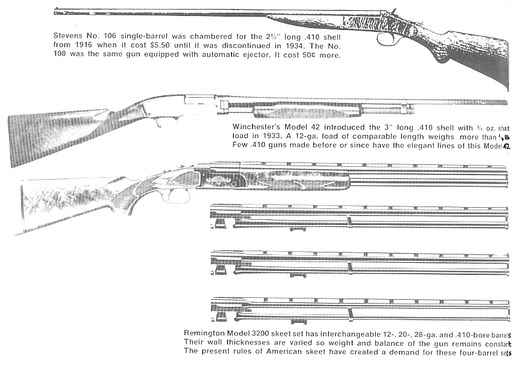
 |
|
Should a .410 be in your battery? - Page 2 |
|
Skeet shooting, by then organized on a national basis, created for the first time a target purpose for the small bore shotgun. Winchesters model 42 pump-action repeater had just reached the market . A better gun to lead the .410s new era can hardly be imagined. Its trim and racy lines give the impression of a refined Model 1912, Winchester’s original hammerless shotgun. The model 42’s slender barrel and magazine tube made its appearance so much like a rifle that the temptation to load rifled slugs for it could not be resisted. Bit weighing only 1/5 oz. the .410 slug was never recommended for big game. The 3” shell also gave the hope for an effective .410 load for wingshooting game. It never quite made it. Although 50% heavier than the ½ oz. load and looking very potent in the long case, overextending the shot column canceled a substantial part of the ¾ oz. loads potential advantage. The original 3/8 oz. .410 load is comparatively longer than the 2 oz. load in a 12-ga barrel. A ½ oz load in a .410 barrel has the same ratio of diameter to length as 2.8 oz of shot in a 12-ga bore. To compare with a ¾ oz .410 load, a 12-ga shell would carry a shot load weighing 4.2 oz. At 25 yards (the standard distance for patterning .410 guns), performance of ¾ oz. loads is best described as consistently inconsistent. |
 |
|
|
The
Model 42 Skeet, the most attractive of its variations, remained popular
until the gun was discontinued in 1963. After May, 1940, the skeet
version was chambered for 2½” Skeet
shooting remains the legitimate reason for the .410’s continual
production. Skeet began as a “gun game for the game gun”. Its
original value as practice for field shooting has been greatly
diminished by basic changes to the rules. In the beginning, the targets
release could be delayed up to three seconds after the shooter called
“pull” |
These rule changes also altered the basic nature of skeet as a competitive sport. Scores of 100 straight with 12-ga. Guns became so common that four guns (shell sizes) are now required in all the major American skeet programs. At the National Skeet Shooting Ass’n 1980 world Championships at Savannah, 36 of the 803 participants in the 12-ga. Event shot prefect scores of 250x250. A straight run of 763 targets made Tito Killian the winner. In the 20-ga. event, 19 out of 768 entrants broke 100 straight. There were 12 scores of 100 straight from the 733 entrants in the 28-ga. event. With the .410, only 6 of the 730 shooters broke 100 straight.
The .410 guns now used for American skeet differ vastly from the trim Model 42 Winchester pump of earlier days. Matched four-gun (12-20-28-.410) sets are popular with the serious competitors. Detachable weights are added to the smaller bore magazine to give all a similar weight and balance. In under and over sets, the barrels and ribs of the smaller bores are made thicker to achieve the same result. Removable barrel inset tubes for 20-28 and .410 allow one 12-ga. gun to be used for all four events. With .410 tubes in place, the gun is as much as a full pound heavier then when fires as a 12-ga. A 9-lb .410 seems both artificial and incongruous but fill a need under the present rules for American skeet.
Reprinted curtesy of :- The
Author :- Robert N. Sears
Previously published in "The American Rifleman" May 1981
| <-- Previous Page |
Should a .410 be in your battery? - Page 2 |